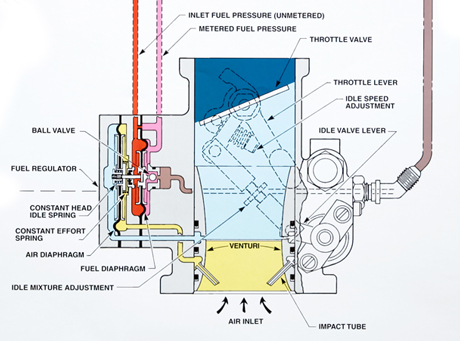Jim_CAK
Line Up and Wait
Yes - I watch his channel all the time. He seems like a great instructor.Check out "The Finer Points", too. Really good channel that doesn't get much attention
Yes - I watch his channel all the time. He seems like a great instructor.Check out "The Finer Points", too. Really good channel that doesn't get much attention
so....what happens when the fuel distributor thingy sticks open?
Hi, I know a thing or two about this.
On your Lycoming the basic description is as follows. You have a mechanical fuel pump that will generally run around 35 psi or so to a servo (exact settings vary). This servo has a venturi (similar to a carb).
The delta-P that you get from this venturi moves a piece of rubber inside which then kicks that ~35 PSI down to a lower number. The delta P is caused by airflow going through the venturi, so this works well for measuring actual airflow.
Either before or after that metering (I forget which) is the pressure reduction caused by the mixture knob, which is essentially a variable orifice to reduce pressure.
After the servo, the fuel goes up to a fuel distributor (or spider) which then splits that fuel flow (pressure) to each of the nozzles (one per cylinder). Those nozzles have calibrated orifices to produce equal flow. This is part of why it's important to keep them clean. The nozzles have screens to allow some small amount of air in with the fuel to help atomize it. This is a continuous injection system, so it's a constant dribble/spray/whatever. However the pressure at the nozzles will vary depending on the engine and the power setting. More pressure = more fuel. I forget the exact range here.
If you have a turbocharged engine the nozzles have boost pressure fed on the outside of the engine as well to prevent the boost from trying to blow the fuel out. It's important to keep these lines clear if you have them or it can cause all kinds of weird fuel flow imbalances.
Certain Lycomings have a fuel return for venting purposes to aid hot starting. I think the restart Cessnas were the main ones with that.
Continental is another ball of wax. It's a simpler concept that ends up being more complex in execution.
Look at this:Thanks for the explanation, Ted!
Nope, no venturi. There are instead four impact tubes that sense the mass flow (!) of air into the throttle body. No venturi there.
The impact pressure of the four tubes guides the fuel flow. There is no venturi.
Well, it's neither before or after... there is one fuel valve, and it's pushed one way by the air impact pressure which represents mass flow of air, and the other way by the flow of gasoline... to deliver the required air/fuel ratio. So no before/after, the two flows act against each other, as modulated by the mixture valve. The throttle opens/closes the butterfly.

